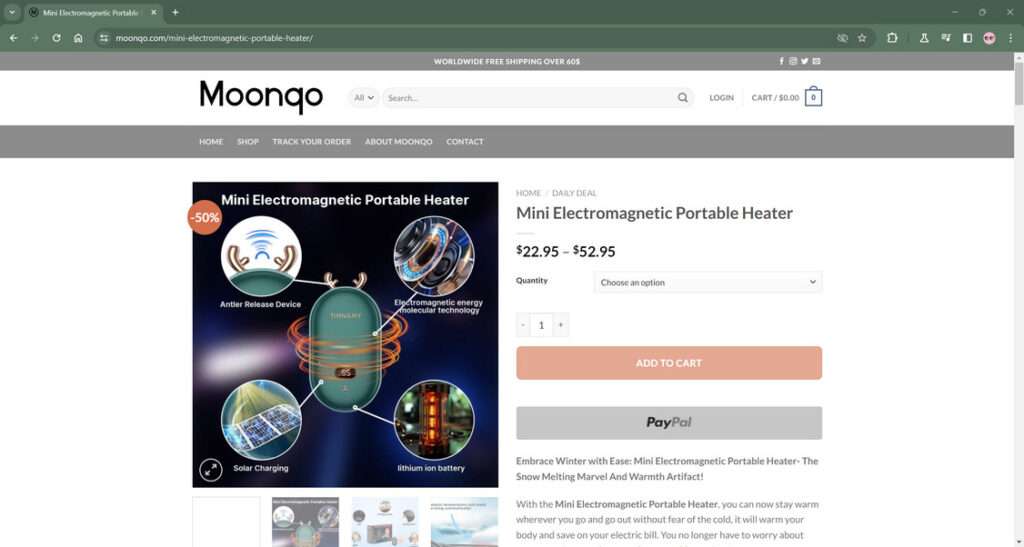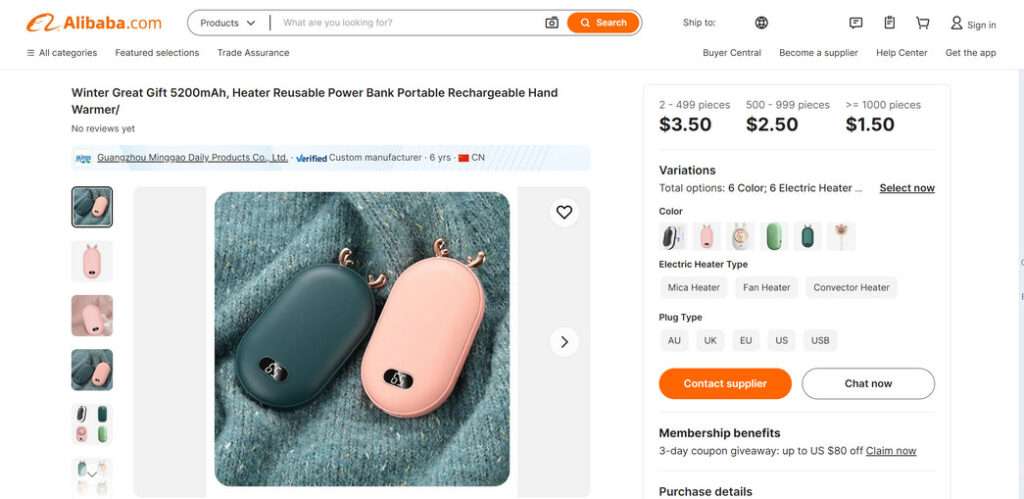Viral advertisements promoting the Mini Electromagnetic Portable Heater are proliferating across social media and inboxes using dubious claims, fake technology partnerships and high pressure tactics to lure in consumers. However, disappointed buyers report this heavily marketed device fails to live up to its bold claims. This article will uncover how this heating scam works and provide tips to avoid getting ripped off.

Overview of the Dubious Mini Electromagnetic Heater Scam
The Mini Electromagnetic Portable Heater scam relies on misusing advanced physics terminology and falsely claiming partnerships with prestigious institutions like NASA to massively exaggerate the capabilities of a simple $3 hand warmer product imported in bulk from Chinese websites.
The deceptive marketing campaign uses compelling Facebook, YouTube and Instagram ads making unbelievable claims by presenting this basic device as leveraging exclusive “electromagnetic energy molecule technology” to achieve remarkable feats like:
- Instantly melting thick, heavy ice and snow simply by coming into contact with the tiny device
- Keeping people warm and comfortable outdoors in frigid, below-freezing winter conditions
- Heating up large 500+ square foot homes in less than 10 minutes
- Saving homeowners 50-75% on expensive winter electricity bills
However, the reality is the actual product is just a $3 hand warmer with a basic built-in battery and heating element purchased wholesale from sites like Alibaba and rebranded.

These cheap hand warmers clearly cannot rapidly melt thick snow piles or maintain livable warmth outdoors in freezing temperatures. And they certainly cannot heat entire homes to comfortable temperatures in minutes.
Yet due to the compelling but nonsensical claims using exaggerated buzzwords referencing electromagnetic frequencies, physics breakthroughs, and NASA patents, victims routinely report getting massively overcharged for these $3 hand warmers.
Many victims pay up to $150 per unit, believing the false marketing presenting them as incredible winter survival innovations rather than the reality of their basic functionality and components.
After sale, refunds are typically impossible to obtain and all complaints get ignored, revealing the true intent is simply to mislead and egregiously overcharge rather than deliver an incredible product as advertised through these reprehensible false marketing tactics.
Read on for a detailed exposé on how this “too good to be true” scam unfolds to massively overcharge consumers through blatantly misleading marketing.
How the Dubious Mini Electromagnetic Heater Scam Works
The Mini Electromagnetic Portable Heater scam follows a deceptive playbook utilizing wild exaggeration and false affiliations. Here’s an in-depth look:
Phase 1: Crafting Misleading Social Media Ads
The scam starts with social media ads portraying the Mini Electromagnetic Heater as a scientific breakthrough in heating using “exclusive electromagnetic energy molecule technology”. They falsely claim it relies on patented NASA inventions which convert natural frequencies into heat and energy.
Some outrageous claims made in the compelling ads include:
- Special electromagnetic waves that instantly melt thick, heavy ice and snow on contact
- Keeping people warm and comfortable in below-freezing winter temperatures
- Heating 500+ square foot homes in less than 10 minutes
- Saving homeowners huge amounts on winter electricity bills
These claims leverage pseudoscience and falsely tie to esteemed institutions like NASA to overhype what are actually $3 hand warmers ordered in bulk from sites like Alibaba. But the average person sees these ads and believes them to be a legitimate groundbreaking technology.
Phase 2: Deceptive Sales Pages Prevent Research and Upsell
After clicking an ad, victims are funneled to sites with more deception. Fake videos show the impossible claims happening in real life. More fake NASA endorsement claims are made. Experts appear to validate the falsehoods.
These sites utilize additional tricks like:
- Fake limited-time discounts of “75% off today only!” to create panic
- Aggressive upselling of 2, 3 or 5 unit packages at steep “discounts”
- No negative reviews visible or ways to ask impartial questions
- No company information, address or contact details provided
The key goal is limiting research into the true source and severely limited capabilities while pushing multi-unit bundle purchases of the overpriced $3 hand warmers.
Phase 3: Refusing Refunds and Ignoring Complaints
Unfortunately, most consumers soon realize they’ve been scammed once the units arrive and fail to perform. Getting refunds on the ineffective Mini Electromagnetic hand warmers ranges from extremely difficult to impossible.
Some common issues faced by victims include:
- Emails and calls being ignored after payment is collected
- Returns refused under claims like “too late for refunds”
- Rejected credit card chargebacks using fake shipping information
- Forced “exchanges” for identical hand warmers instead of refunds
- No way to contact the scammers perpetrating the false marketing
This scam playbook shows the true intent is to mislead and overcharge rather than deliver an incredible product as advertised. These egregious false marketing tactics scam victims into paying 5x, 10x or even 20x what these $3 hand warmers cost.
What To Do If You Purchased a Mini Electromagnetic Heater
If you unfortunately purchased one of these overhyped $3 hand warmers:
1. Dispute the charges immediately: Call your credit card provider and request a chargeback refund, reporting the charges as fraudulent. Provide details showing how the advertised capabilities are false.
2. Gather evidence: Take photos and videos showing the device failing to perform as depicted in the ads and websites.
3. File complaints: Submit reports about the scam to the FTC, state attorney general, RipOff Report, and other consumer protection sites.
4. Leave reviews: Warn others by leaving negative reviews on Trustpilot and elsewhere about the misleading ads. Social media posts also help spread awareness.
5. Escalate with your bank: If chargebacks fail, request arbitration from your credit card issuer to recover the funds. Providing evidence seems to help get refunds.
With diligence and persistence, many scam victims report getting refunds from their credit card provider directly by exposing sham overpriced products like these $3 hand warmers. Prevention is the best approach though.
Avoiding Mini Electromagnetic Heater Scams: What To Know
Here are tips for spotting and avoiding questionable Mini Electromagnetic heater advertisements online:
- Outlandish performance claims – Any heater promising to instantly melt heavy snow is almost certainly exaggerating massively. Apply heavy skepticism to such claims.
- Fake endorsements – Watch for questionable “reviews” and partnerships seeming too amazing to be true with no verifiable details.
- Leveraging sciencey-sounding buzzwords – The use of advanced physics terminology is often used to over-sell underperforming products.
- Vet sellers thoroughly – Check companies advertising online for warning signs like no address before purchasing.
- Inspect locally first when possible – View and test products at local stores you trust rather than falling for online hype.
- Avoid “breakthrough” products – Any gadget seeming too incredible to be true likely is. Stick to proven brands with impartial feedback.
Staying vigilant and doing careful research is key to avoid getting misled by exaggeration and pseudoscience used to push questionable products online. Shop wisely by only buying from reputable retailers that you can fully verify. Prevention is your best protection.
Frequently Asked Questions About the Mini Electromagnetic Heater Scam
Misleading Mini Electromagnetic heater ads are proliferating online using exaggerated claims and fake demonstrations. This FAQ answers key questions about identifying and avoiding this heating scam.
What exactly is the Mini Electromagnetic heater scam?
The Mini Electromagnetic scam uses viral social media ads presenting cheap $3 hand warmers as incredible scientific innovations by falsely claiming they leverage exclusive electromagnetic energy technology from NASA to achieve unbelievable feats.
How are the Mini Electromagnetic heaters advertised?
Scammers run Facebook ads, YouTube videos, and TikToks making absurd claims about instantly melting snow, heating homes rapidly, and keeping people warm outdoors in winter conditions by using deceptive terminology, edited visuals and fake expert endorsements.
What misleading claims do the Mini Electromagnetic ads make?
Some dubious claims are exclusive patented technology from NASA, leveraging special electromagnetic frequencies to melt ice/snow instantly, heating 500+ square foot homes in minutes, saving huge on winter electricity bills and keeping users warm in freezing temperatures outdoors.
Where do the fraudulent ads lead if you click on them?
The fake ads funnel victims to shady websites packed with more fake demonstration videos, misleading terminology, false claims and discounts urging the purchase of multiple units before a fake timer runs out.
What happens after a victim purchases the device?
Many report the sellers instantly disappear after taking payment, leaving no way to contact them when the $3 hand warmers arrive and unsurprisingly fail to actually rapidly melt heavy snow or heat entire homes as absurdly depicted in the fake ads.
What are signs of a Mini Electromagnetic heater scam?
Red flags include unbelievable capabilities claimed, fake NASA affiliation claims, no company address provided, refusing refunds, deleting negative comments, and having no way to contact the seller post-purchase.
What should you do if you purchased one?
If you realize it’s a scam device, immediately file a chargeback request with your credit card provider disputing the charges as fraudulent, provide evidence of the false advertising, and file complaints about the misleading business practices.
How can you avoid Mini Electromagnetic heater scams?
Apply extreme skepticism to claims that seem too amazing to be true, like instantly melting snow. Check seller reputations thoroughly and only buy from retailers you can fully verify. Watch for indicators of exaggerated or misleading marketing. Stick to trusted brands with impartial reviews.
The Bottom Line on the Mini Electromagnetic Heater Scam
In summary, key facts to remember about the Mini Electromagnetic heater scam include:
- Slick social media ads use wild performance claims and false affiliations to generate hype
- Deceptive sales pages push urgent multi-unit bundle purchases to overcharge victims
- The actual $3 hand warmers severely underdeliver on the capabilities touted
- Scammers typically ignore refund requests and complaints about the items
- Only buy winter gear from retailers you can thoroughly vet and trust
- Being persistent with your bank can pay off in getting at least partial refunds
Hopefully this article provides helpful details on how exaggerated and misleading marketing can be used to egregiously overcharge for underperforming products like these $3 hand warmers. Stay vigilant for overhyped “scientific breakthroughs” out to scam rather than satisfy savvy shoppers through false marketing. Your best protection is precaution.










